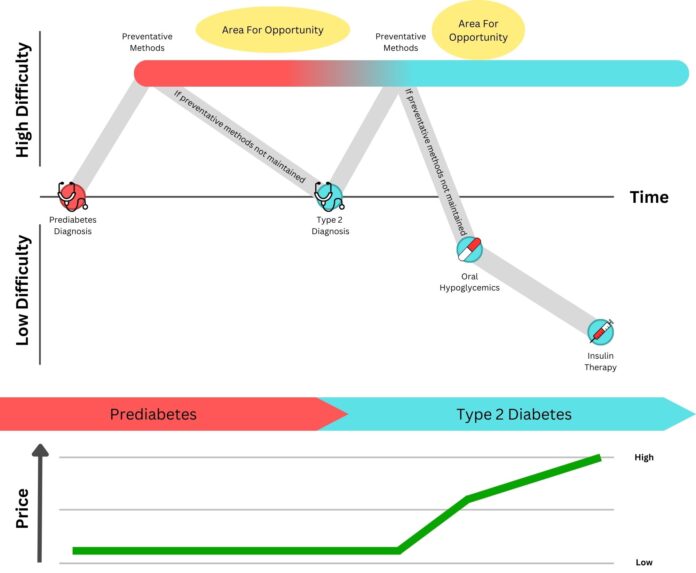Every year in the United States, millions of Americans are diagnosed with type 2 diabetes. Out of those millions of people, 1 out of every 4 are currently taking insulin to manage their condition (Type2DiabetesFAQs, 2012). In a world filled with extremely high tech and advanced medical solutions why are there still so many patients struggling to manage type 2 diabetes? This is what I was seeking to understand with my research. What are the current methods of prevention and management of this disease, and what can be done to prevent so many patients from requiring insulin therapy? My findings around this topic area are that it is less that the tools are inefficient, but the motivation behind keeping up with these methods.
There are so many aspects to managing a chronic disease like type 2 diabetes, so I conducted a lot of secondary research into many different areas, some more related to healthcare than others. I hoped to gain a broader perspective of the overall issue through divergent thinking and research. The first of these articles that I will mention is titled “Creative Arts Therapy Programs Can Help Healthcare Workers Dance, Write and Draw Their Way Through Burnout” (Moss, 2024). This article talks about the burden that many healthcare professionals take on while working in their field. It takes an extreme emotional toll on healthcare workers to deal with these stresses every day. Many of these healthcare workers, to maintain this professional appearance, mask their emotions and carry on their day. A clinical test was conducted using healthcare workers participating in art therapy. This study showed that there was a significant reduction in stress related to their profession.
This article is relevant to my topic of type 2 diabetic patients, because there is often a great deal of stress that they feel around the treatments that they face. Creativity and imaginative thinking seem to aid well in the reducing of stress. With this in mind I created a design conjecture, seeking to show this idea in a creative and fun way.
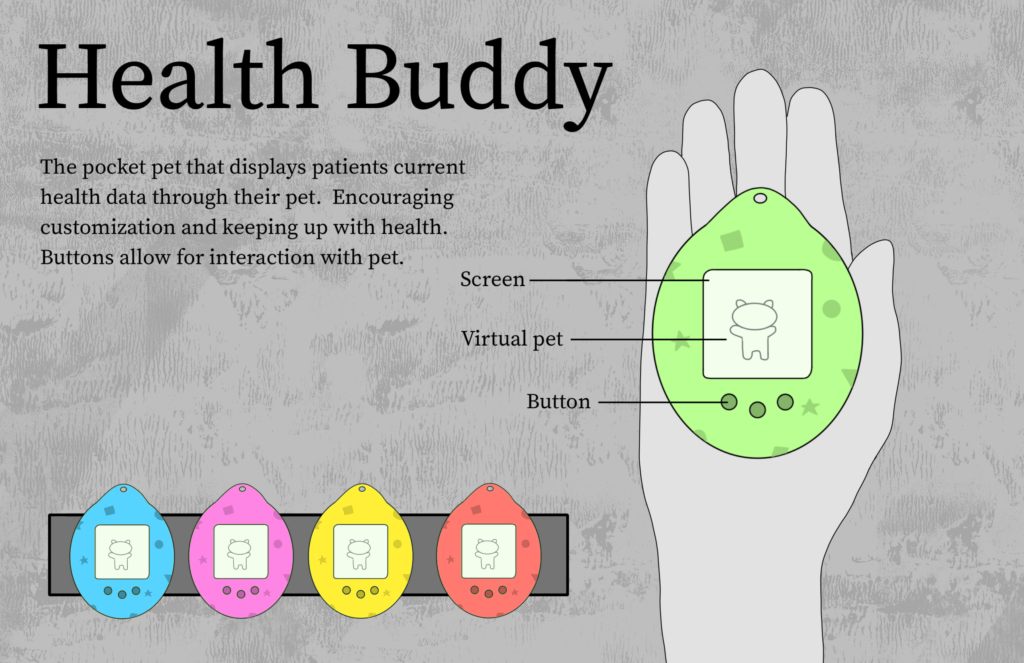
This is the Health Buddy. It encapsulates the idea of using creativity and play to aid in alleviating the stress of the treatment. This product is a play off of the Tamagotchi toy from not too long ago. Your virtual pet in the Health Buddy can be customized to your liking as well as interacted with. The virtual pet’s conditions mimic and allude to what your own body needs. This is done through a wireless connection to a small implant within the body. This lets the patient know what they need to do to manage their condition in a fun and less serious way. While this product may not be the perfect solution to the larger problem at hand, it points out some interesting aspects to keep in mind for final design choices. Through this research, I conclude that design has the power to create products that are fun and spark creativity, aiding in reducing stress, and promoting the management of a condition.
The next area from which I looked to pull inspiration and a better understanding of the problem area, is the business world. From this research, I gained a new and interesting perspective on the issues surround the healthcare experience. One article that I found is titled “Here’s Why People Resist New Technologies” (Howarth, 2017). This article talks about how technology is evolving at an extremely fast rate, and humans tend to have a resistance to trusting these technologies at first. The article talks about being open to and having communication about the technologies with others. This connects well to the healthcare field in that people tend to have a lot of anxiety around new medical treatments. Patients tend to find stress in not knowing everything that their care will entail or have general stress and anxiety around starting new treatments. Addressing this stress and reducing resistance to new medical treatment/technology requires communication and transparency between healthcare provider and patient. Giving adequate information as well as continuous support around the patient allows for reduced stresses around this new form of treatment. With this idea in mind, I created design conjecture to look at a fun way of increasing trust between patient and healthcare provider. This conjecture aids in reducing stress and helping answer questions from patients who may be unsure.
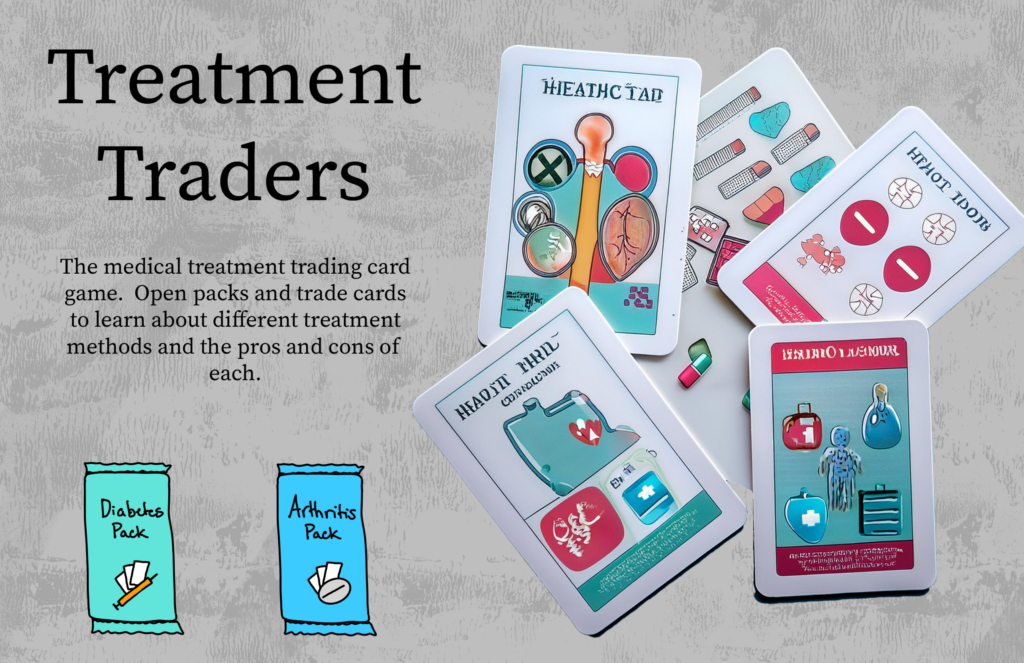
This is Treatment Traders, the medical treatment trading card game. Patients can open packs and trade their cards with other patients to learn about different treatment methods and the pros and cons of each. This conjecture supports creating transparency and building relationships between patients and doctors, as well as other patients. The different packs contain treatment methods related to that specific condition.
While this idea may not be the most realistic, its aim is to create conversation about a specific topic area. I held multiple conversations with my colleagues about how design can be used in a similar way and be effective. We talked about how design has the opportunity to create a transparent and open environment where patients can express their stresses. Design can be used to create fun and engaging activities that help inform the patient while reducing stressors.
The last area from which I pulled outside inspiration was in the world of science and technology. I looked at many different examples of new and emerging technologies some in the healthcare world and some not. From this I learned a lot about the aims of designers and engineers when creating this new tech and what issues they are trying to alleviate. One example I looked at was an article written by a lifelong pilot, giving his perspective on what autopilot is and does on an aircraft. One of the main points of the article is that technology is rapidly improving. While there are many operations of an aircraft that have become automated, it is heavily the pilot’s responsibility to maintain and control these systems. He makes the connection to an operating room, that there are so many things done for the surgeon, but ultimately the surgeon needs to know what they are doing and are responsible for carrying out the surgery.
This relates to my topic overall in the fact that implants and technology in the medical world is vastly improving, however it is still necessary for the doctors to have input as well as the patients still need to be involved in their own care. In the case of type 2 diabetes, it is very important that the patient still maintain their preventative strategies alongside any prescriptions given by doctors.
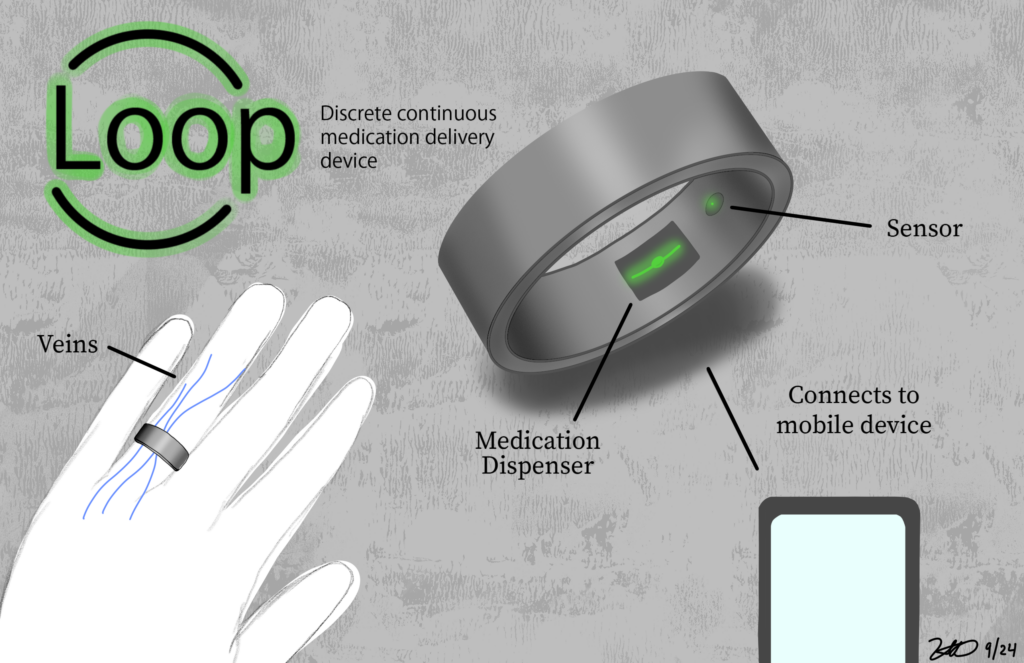
This conjecture combines the ideas of automation and patient control into a product. The Loop system is a wearable device that slowly releases medication into the bloodstream. This device can be monitored by the patient from their mobile device and allows for adjustments of treatment amounts. This conjecture brought up many talking points between my group and me. We talked about how it can be worn, could it be customized, how it works, importance of charging, and if battery can interfere with care. Many of these raised questions help me understand what it is people expect to see in products like this. Overall, this gave me an understanding of how design can create products to relieve the mental burden put on patient’s day to day living. Being able to automate certain aspects of care helps in reducing stresses.
Along with secondary research, I also conducted primary research. One of these methods being a survey, and the other being an interview. From these, I better understood diabetes as a whole and recognized the struggles around this health complication. From the interview, I learned about the different types of diabetes, as well as some of the preventative methods taken to maintain glucose levels. After conducting the interview, I had gained enough information to begin creating and sending out a survey.
My method for collecting responses for the survey was Facebook. I posted in different Facebook groups as well and created posts seeking to get respondents to my survey. I received 98 total respondents, with 63 of them qualifying for the survey. To qualify, I was looking for people who either have type 2 diabetes or prediabetes. Some of the most relevant data I found was the 81% of participants answered having difficulty maintaining weight loss methods, and 74% rated losing weight as an effective method for managing diabetes (n=43). I also found that 1/3 of respondents reported low motivation for managing their condition before insulin treatment (n=57). These statistics tell me that things like weight loss are effective methods for people managing diabetes, however people find difficulty in maintaining these methods and sometimes lack motivation to keep up with them.
Understanding the importance of expressing creativity, creating transparency, maintaining human interaction, and creating good motivators helped me in finding my focus area for the project. My focus is reducing stress and increasing motivation through creativity and interactivity. For this, my stakeholders would include type 2 and prediabetes patients, doctors and healthcare providers, as well as family members of the patients. This would impact patients the most because they would directly interact with the product/system. Doctors would need to be involved in tailoring this system to the patient’s exact needs. The family and friends of the patient would also interact with this in being a social supporter of the patient in maintaining these treatments.
At a critical point in the patient’s journey, just after diagnosis, is where this product will seat itself in the patient experience. While I am unsure of the products final form and function, it will aim to integrate into the patient daily routine, aiding in their treatment before more aggressive treatments are taken. This offers a preventative approach to managing the condition.
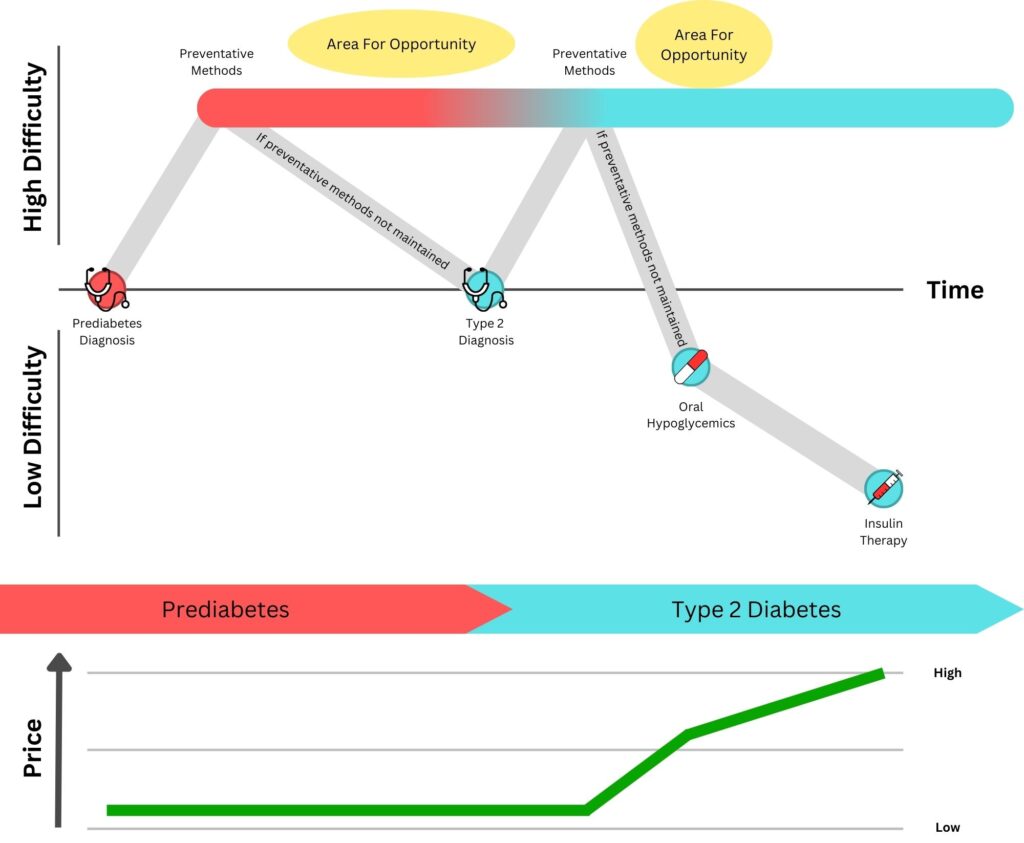
After doing much research into many different media and articles, I was able to find a focus of reducing stress and increasing motivation through creativity and interactivity as a preventative method of managing type 2 and prediabetes. Design has a great opportunity to make a large impact on this specific time in the patients care, as there is not much being done to aid in this preventative stage. My design problematic is “how can design increase motivation in type 2 and prediabetics, to decrease the probability of more invasive and aggressive treatments?”.
Sources
Conversation, T. (2024, September 4). Creative arts therapy programs can help health care workers dance, write and draw their way through burnout: Opinion. pennlive. https://www.pennlive.com/opinion/2024/09/creative-arts-therapy-programs-can-help-health-care-workers-dance-write-and-draw-their-way-through-burnout-opinion.html
Howarth, J. (2017, November 20). Here’s why people resist New Technologies. Bentley University. https://www.bentley.edu/news/heres-why-people-resist-new-technologies
Type 2 diabetes faqs. Diabetes Education Online. (2012, September 18). https://dtc.ucsf.edu/types-of-diabetes/type2/understanding-type-2-diabetes/type-2-diabetes-faqs/#:~:text=Historically%2C%2030%25%20or%20more%20of,to%20control%20their%20blood%20sugars.
We are told that planes basically fly themselves. how true is this?. AskThePilot.com. (2017, November 3). https://askthepilot.com/questionanswers/automation-myths/

